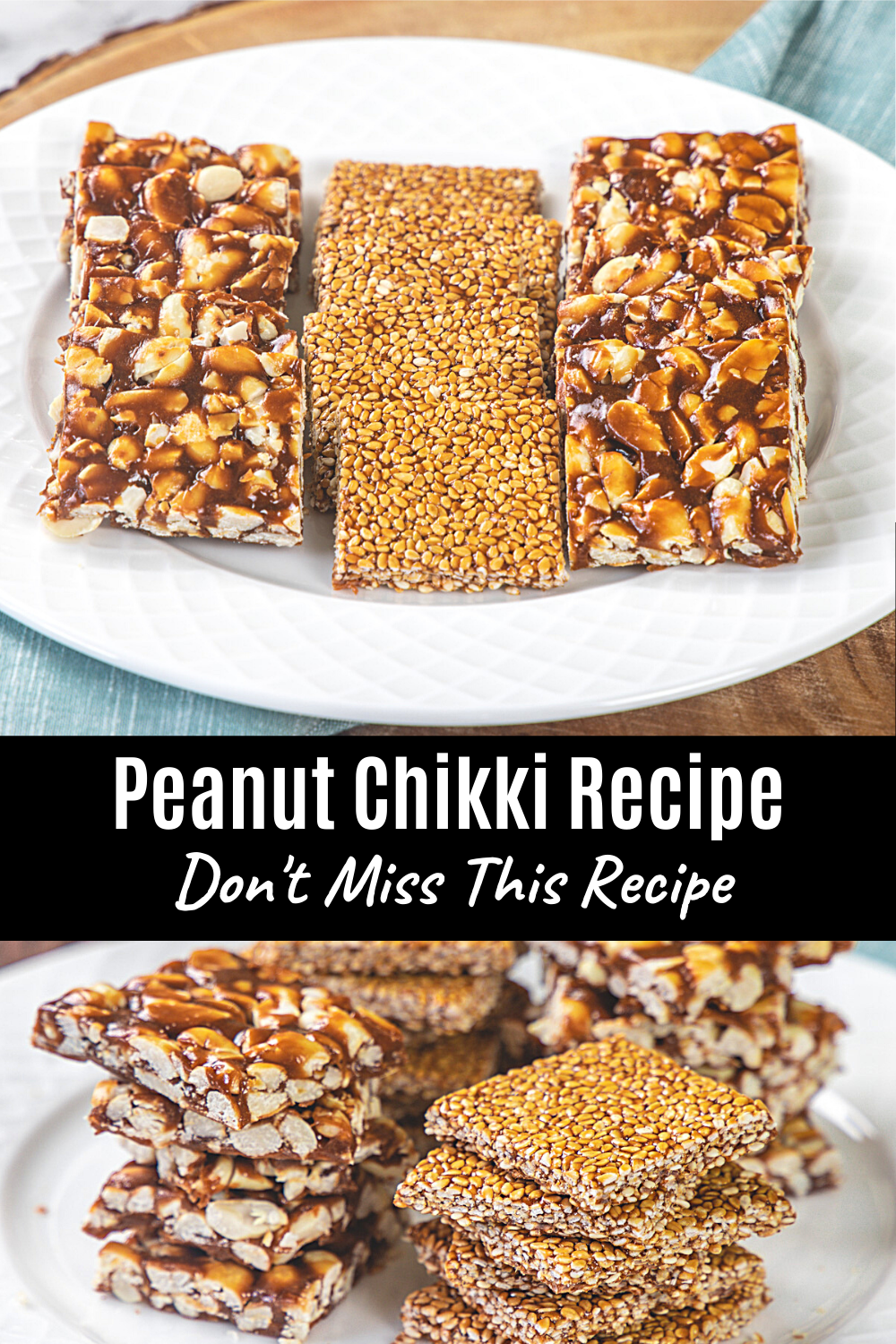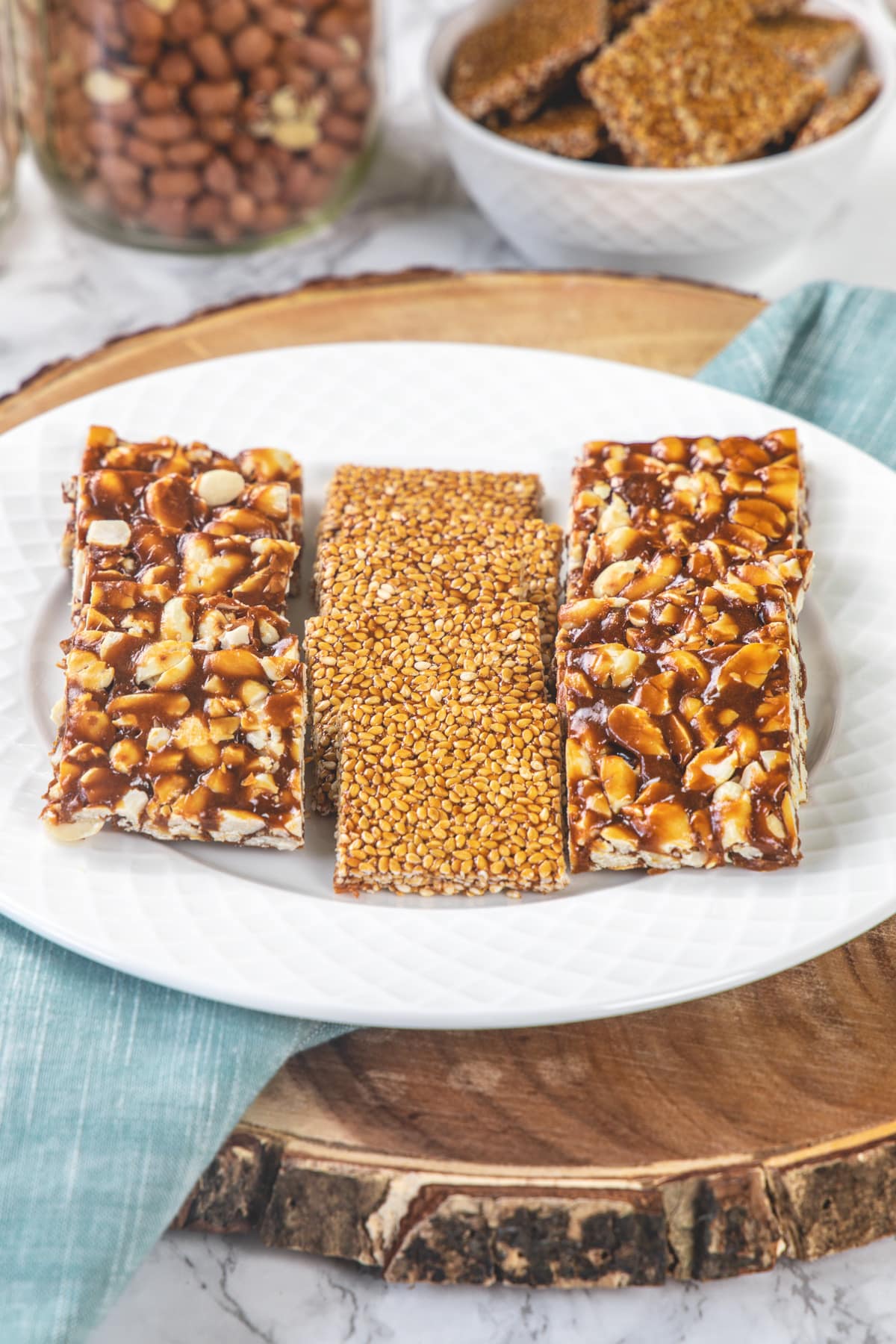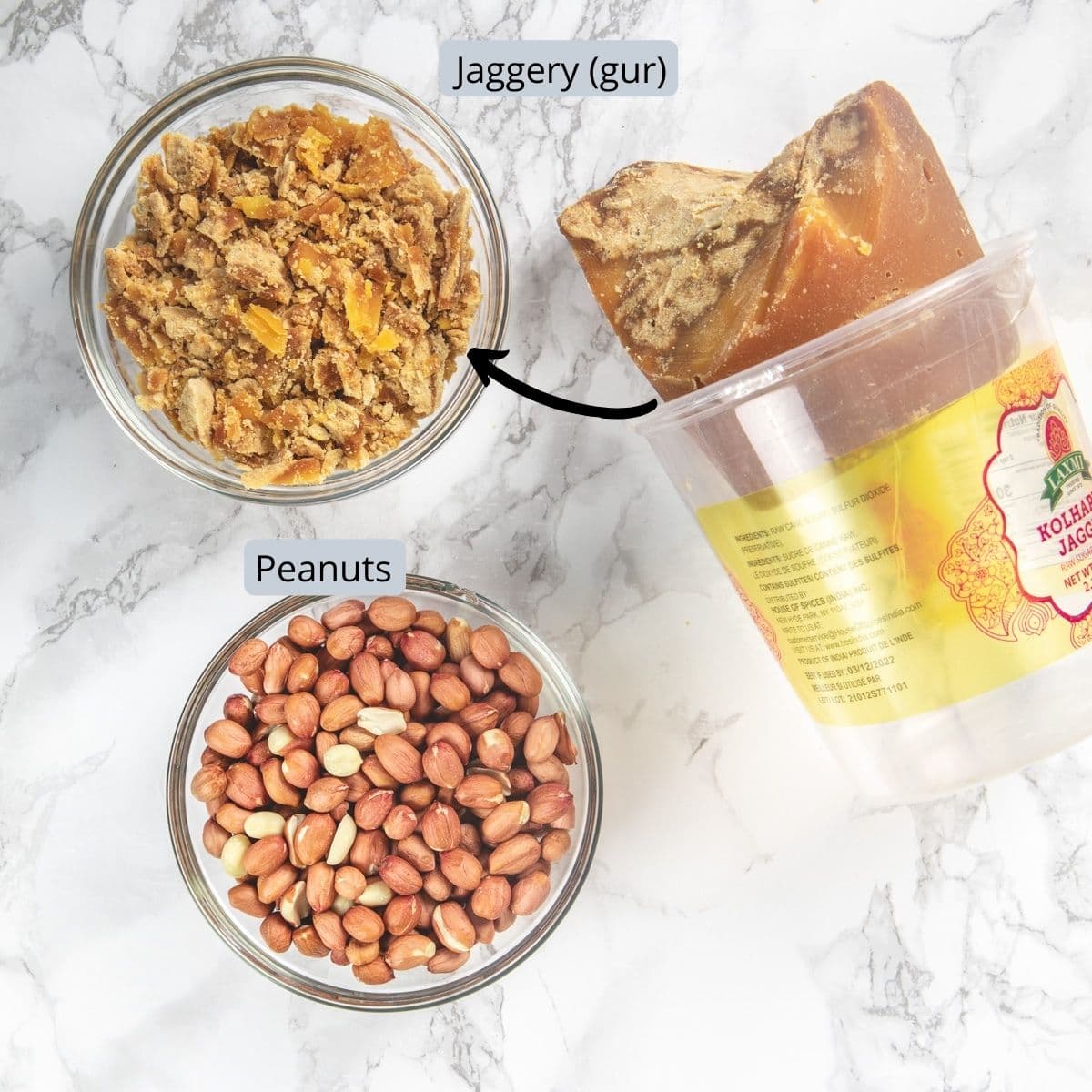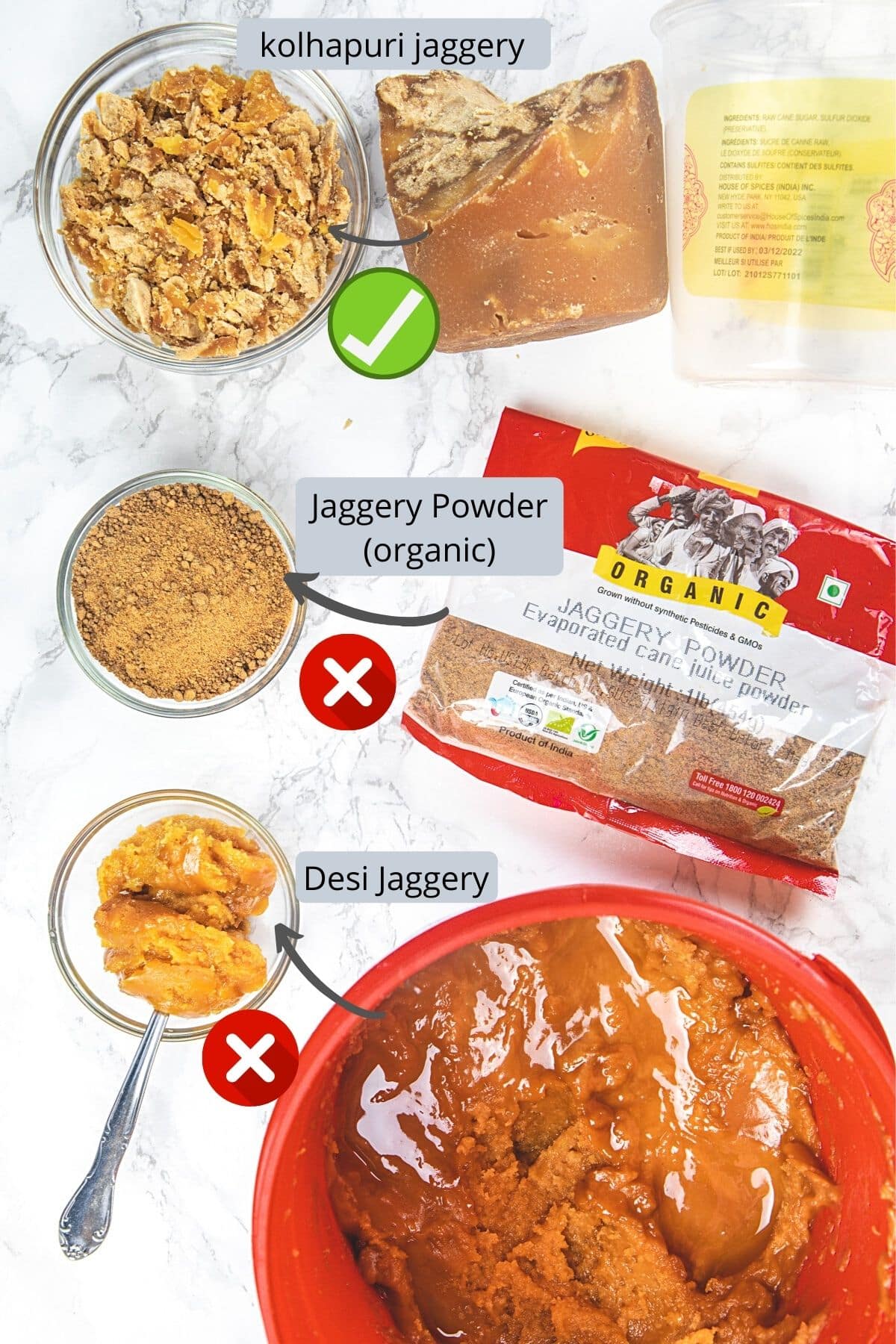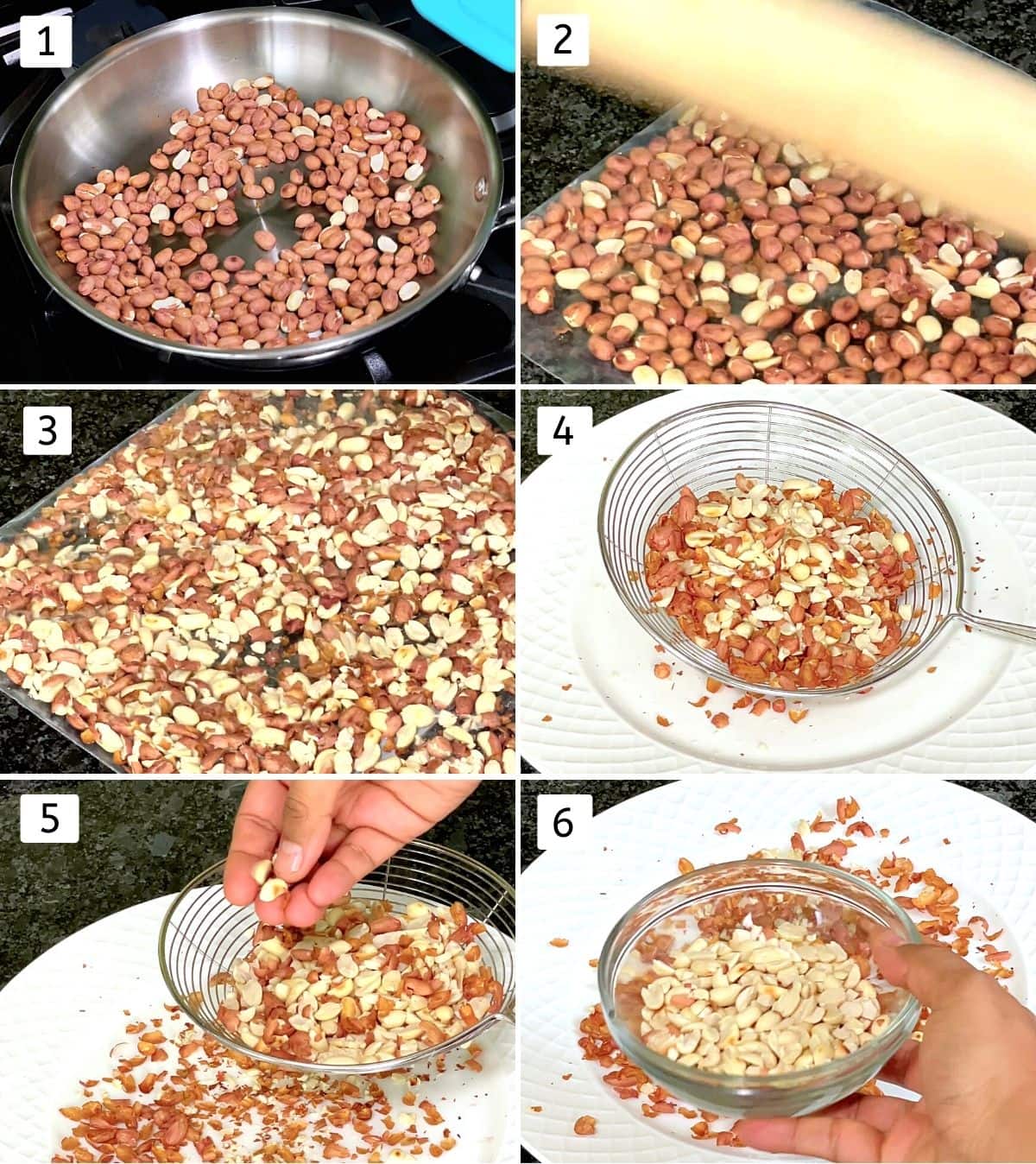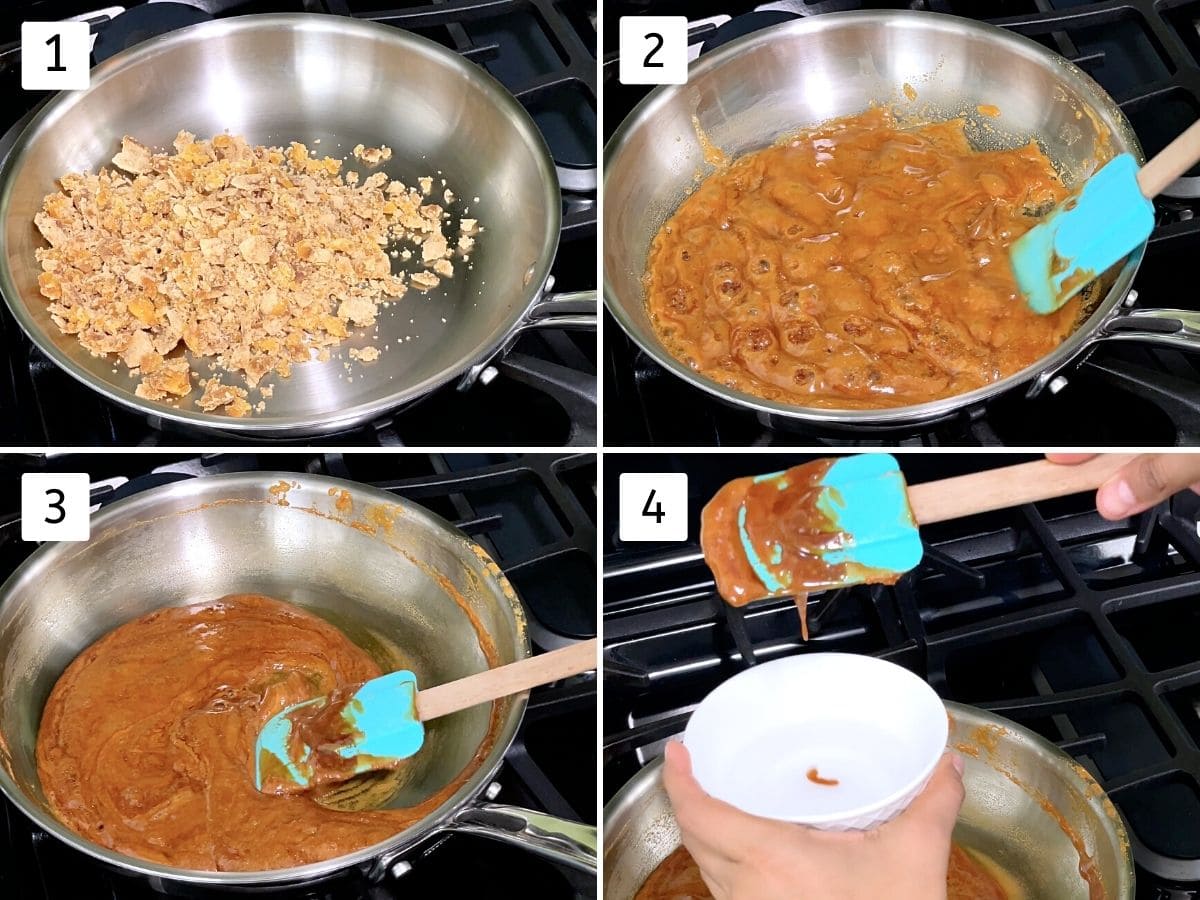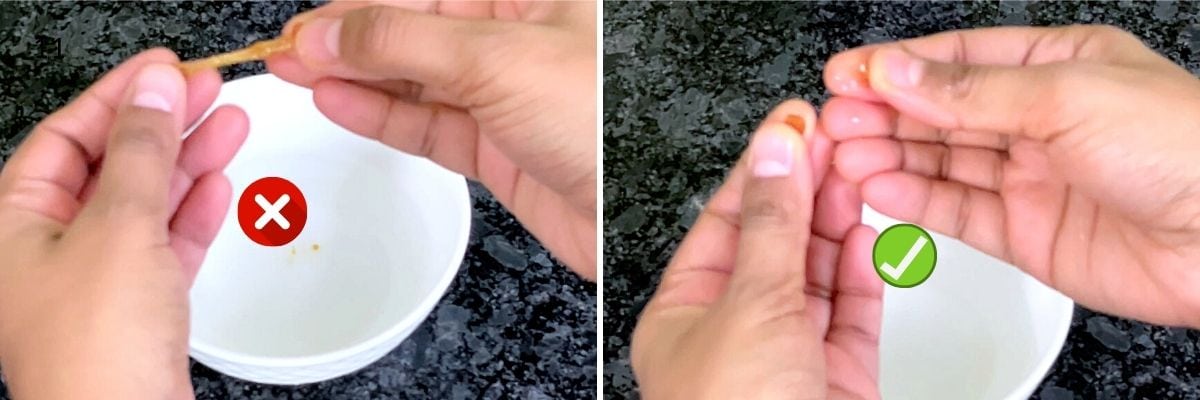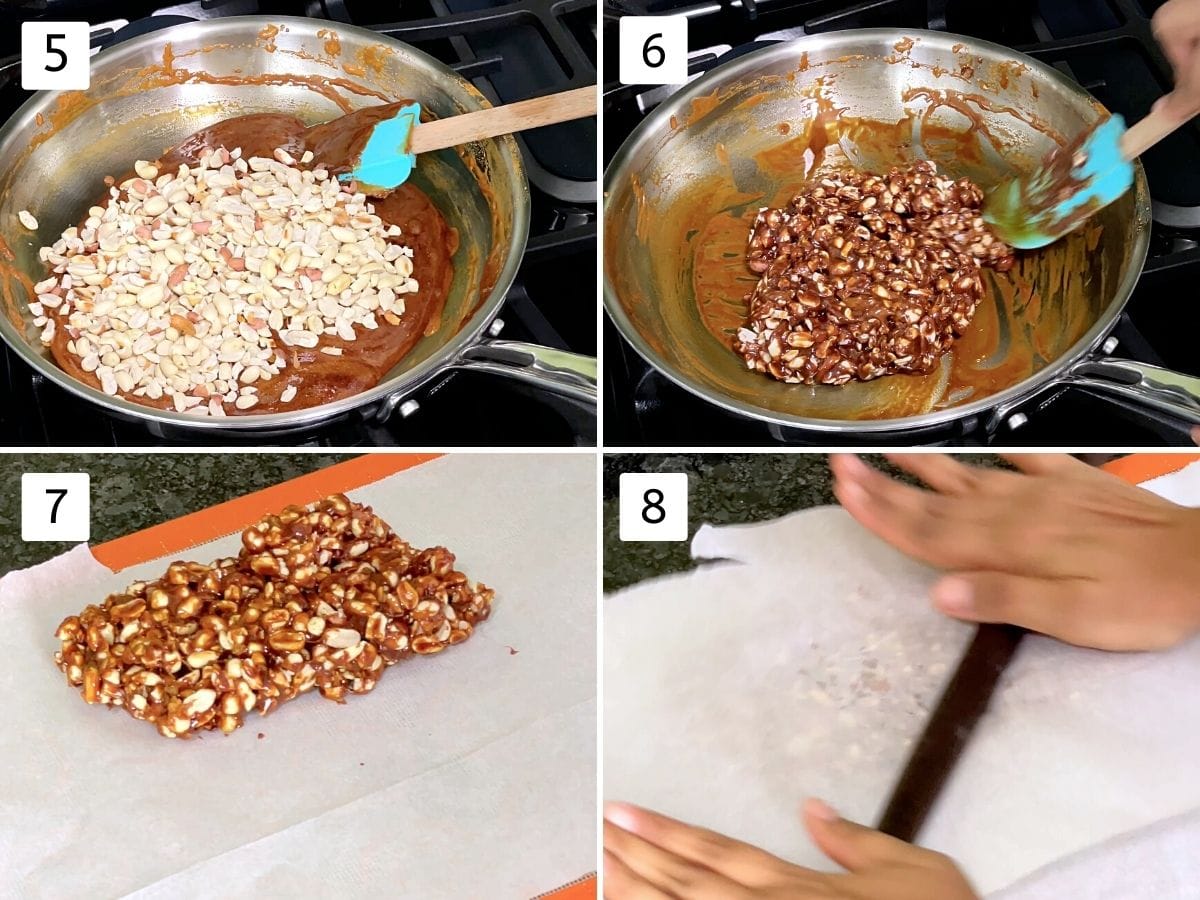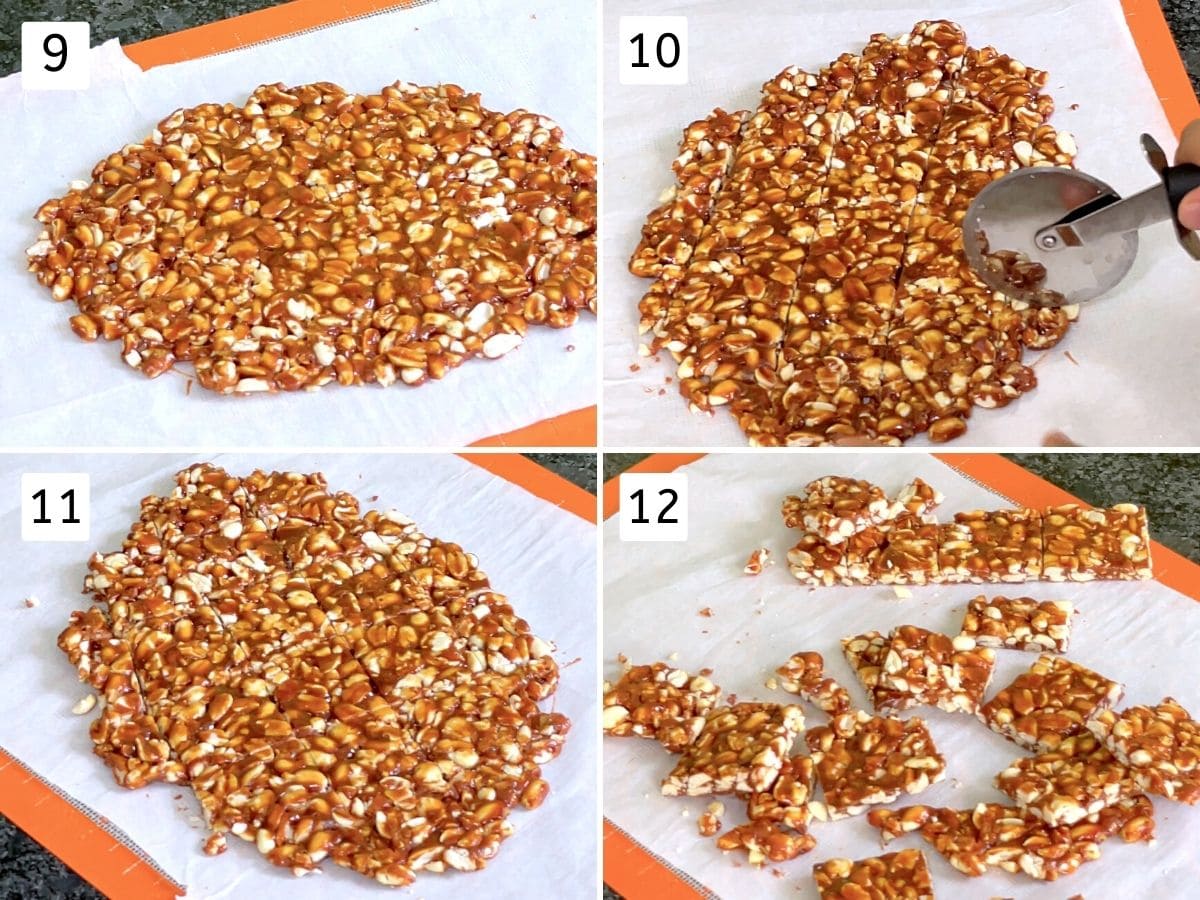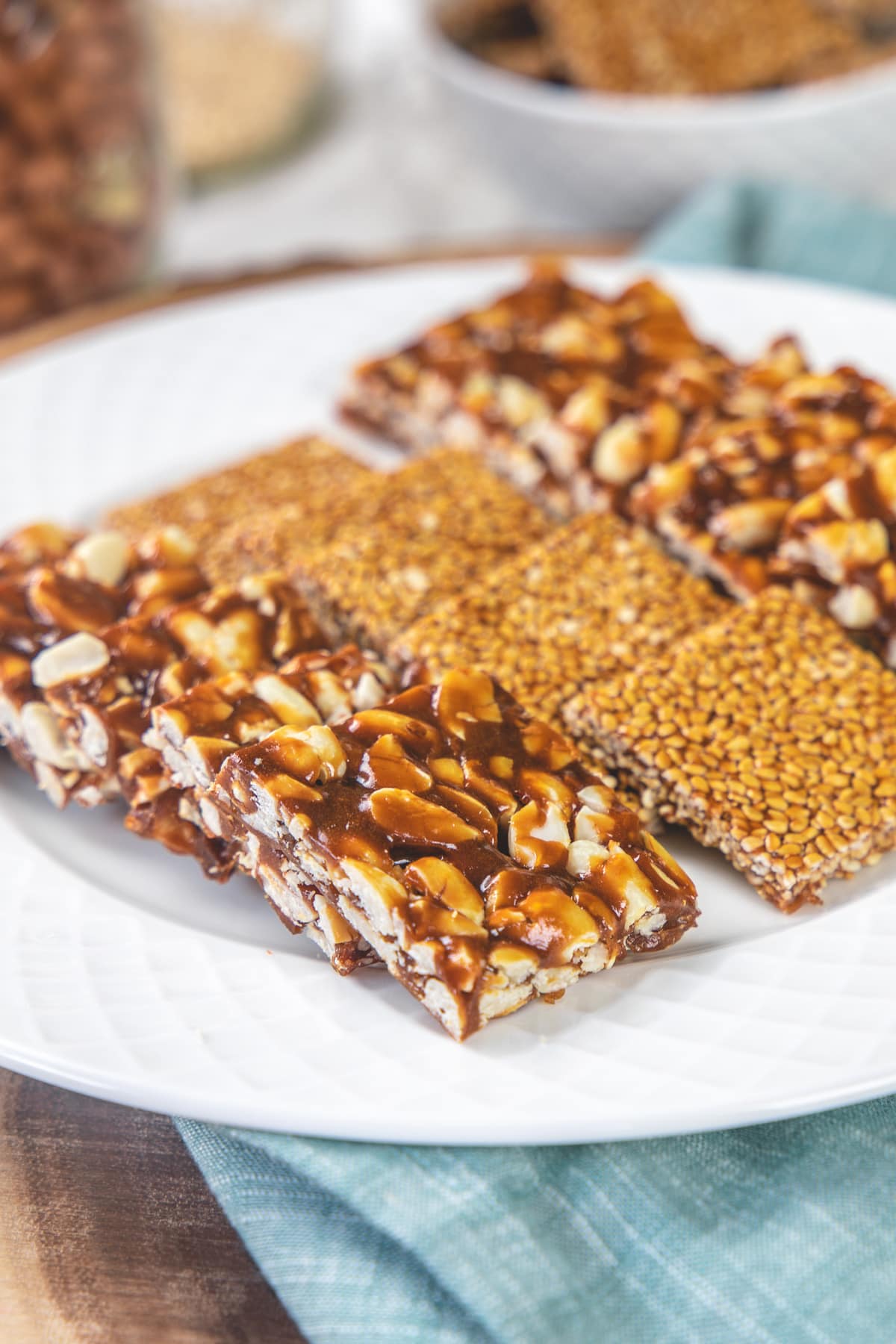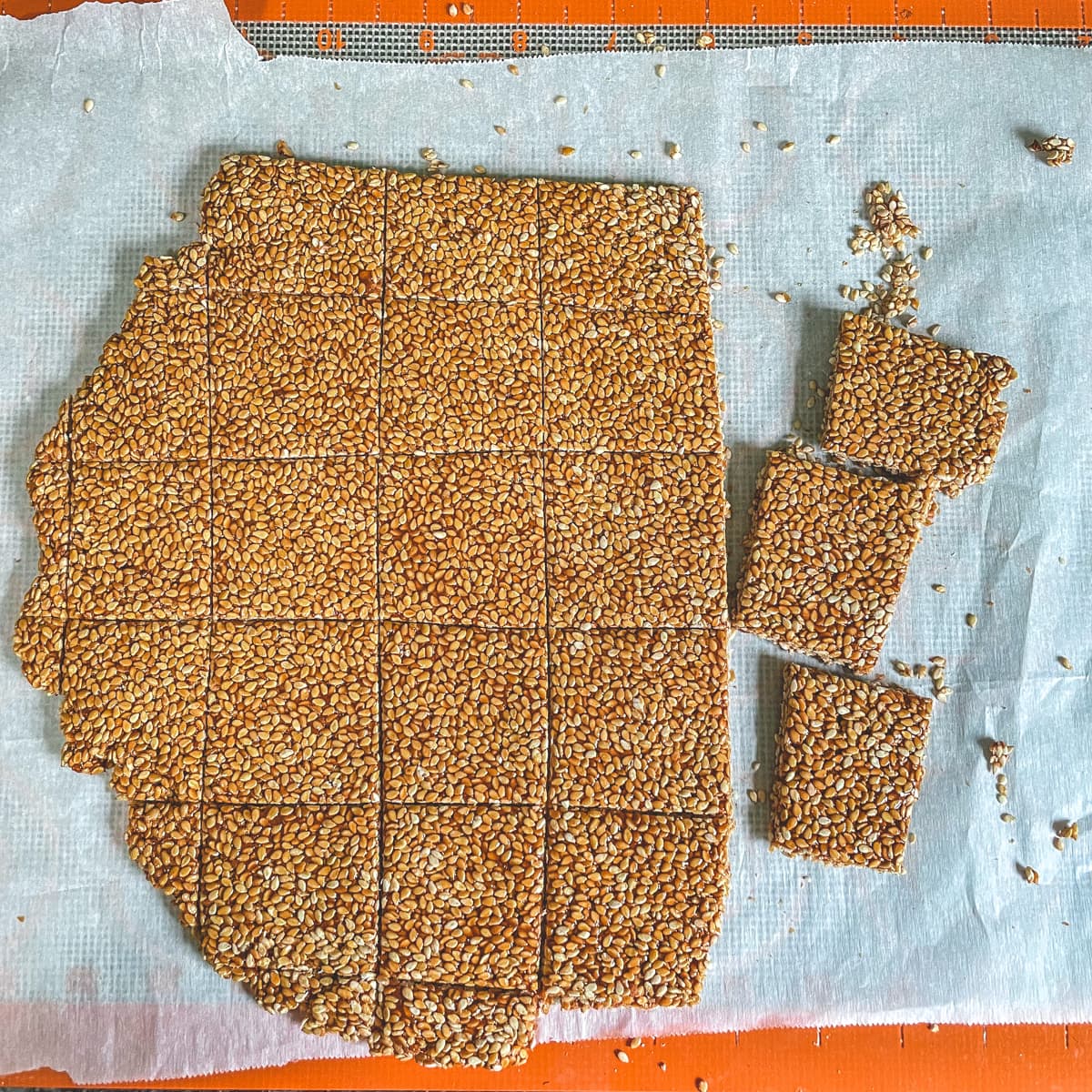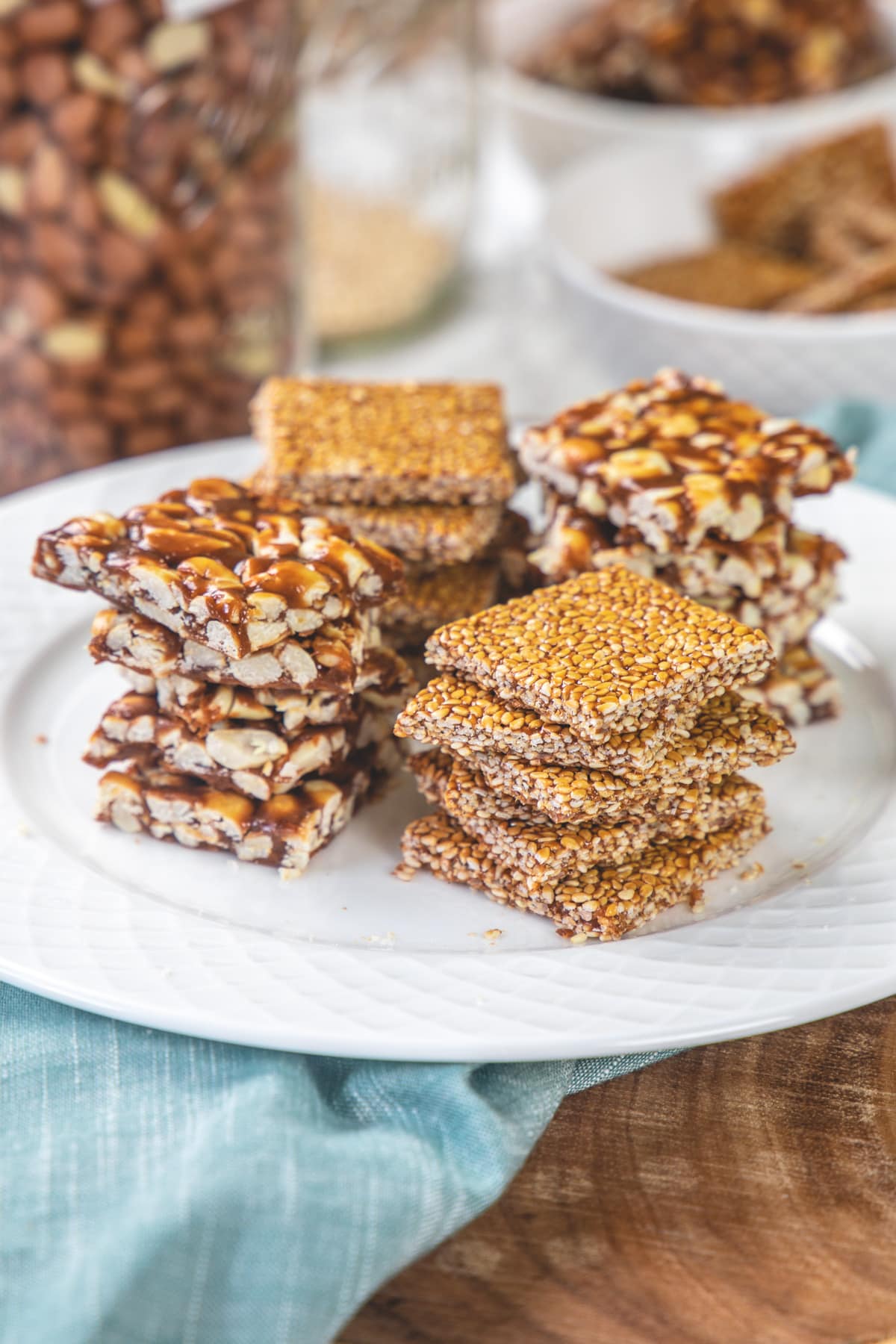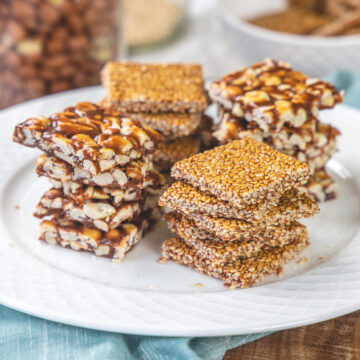To make this chikki (gajak), you’ll need 2 ingredients and 30 minutes only.
What Is Chikki?
Chikki is a traditional Indian sweet mostly made with peanuts and jaggery. It is like sweet candy brittle but it is refined sugar-free, high in nutrients and healthy. Many other variations are made with sesame seeds, roasted chana dal (dalia), puffed rice (murmura), amaranth seeds (rajgira), mixed nuts, etc. Different regions of Indian have different names like gajak, gur patti, mittai, etc. Peanut chikki (and other varieties too) are made during the Makar Sankranti festival (14th January) and the winter season as a snack. When I think of Makar Sankranti, it reminds me to enjoy undhiyu poori, jalebi, til ladoo, and this peanut/ til chikki.
❤️ You’ll Love This Chikki Recipe
Preservative-free. The store-bought chikki might have corn syrup, glucose, other flavor additives and sometimes they use a mix of sugar and jaggery. Vs homemade is made with jaggery only and your choice of nut/seed. Super easy to make. I know making peanut chikki at home is very tricky and temperamental. It’s also true that by following simple, straightforward method and helpful tips along the way you’ll realize that it is easier to make than you’ve likely to heard. The right amount of sweetness: follow the proportion mentioned below in the recipe card and you’ll get the perfect sweet taste. I don’t like super sweet stuff. Healthy snack: This makes a healthy, filling snack for kids and adults. My daughter loves it as an afterschool snack during the winter season. Peanuts (or other seeds) are good fat and jaggery is really good for your gut health.
🧾 Ingredient Notes For Peanut Chikki
To make peanut chikki, you’ll need just 2 ingredients – Peanuts and jaggery.
Peanuts: You’ll need to dry roast the peanuts, then remove the skin and slightly crush the peanuts. (or break it into halves). If you have skinless peanuts then that step is eliminated for you. If buying especially for this recipe then I would buy skinless ones, but I am making it what I have in my pantry. And that is peanuts with skin.
Jaggery: There are many types of jaggery available in the market. You’ll need to use the right type to get the perfect chikki.
Right type: Kolhapuri jaggery which comes in a solid, almost cone shape. That comes in a plastic container. But this kind to make chikki and avoid sticky, stringy texture. The wrong ones are jaggery powder or desi gur. These varieties will make stringy jaggery syrup and it makes it hard to roll after adding peanuts. Plus, it even sticks to the parchment paper. So you can’t remove the paper after rolling and will make a huge mess. I use jaggery powder for making ladoo, so it can be distributed evenly in the ladoo (like til ladoo) mixture. For my day-to-day cooking (like Gujarati dal, sukhdi) or just eating a teaspoon of it along with the meal, I like to use desi jaggery. That’s why you see the big bucket of it in the pic below. It is chemical-free, less-processed. It is sticky, paste kind and comes in a bucket-type plastic container.
👩🍳 How To Make Peanut Chikki? (Pics)
Roasting Peanuts:
- Dry roast the peanuts on medium-low heat with stirring constantly. How do I know peanuts are roasted? 1. Skin starts to come off easily. Take one peanut, cool slightly and press between thumb and finger, skin should come off without any effort. 2. You’ll notice the slight brown color or spots on the skin as well as on the peanuts. 3. You’ll notice the aroma of roasted peanuts.
- Remove it to a plate and let it cool down slightly (until warm). Then add into a ziplock bag. Stat smashing with a rolling pin.
- Smash lightly that peanuts break into halves and skin will come off. Don’t overdo it that you’ll end up with crushed peanuts and not halves. Some may get crushed slightly and that is fine.
- Now remove it to a strainer (shown in the pic) and shake. Most of the skin will get removed and the remaining may float on top, pick up those and discard them.
- Some peanut skin may stay intact, you can use your finger and thumb to remove and split it in half.
- Take skinless, halved (slightly crushed) peanuts in a bowl and keep them aside. Prep: Making Peanut Chikki Recipe:
- Take jaggery in a pan and turn the heat on medium-low.
- Keep stirring constantly and cook the syrup until it reaches the hard ball syrup stage. In beginning, jaggery will get melted and turn into a light, runny and bubbly syrup.
- Continue cooking (with stirring continuously to avoid burning) until jaggery gets darker in color and syrup will thicken.
- As soon as you notice the it is starting to thicken, you start checking the consistency by adding a few drops of syrup into the bowl of cold water. It should be firm, brittle and snap easily. While checking the consistency, turn the gas heat to the lowest possible to avoid burning or overcooking the syrup. NOTE: We are looking for hard ball stage (250-266 F) of syrup consistency. If you have a candy thermometer then it should reach between 260-265 F. If you don’t have a candy thermometer then use the old-fashioned method by using a bowl of cold water. Checking the syrup consistency: Left pic: the drops of syrup added into the water don’t solidify. It is stretchy and stringy. This is not the right stage. You’ll need to cook it more. Right pic: As soon as you add the drop of syrup in the water. It will harden, solidify and when you try to break, you can snap it easily. If you drop those hardened balls on the counter or tap on the sides of the bowl, you’ll hear the crunchy sound. This is the right stage of syrup consistency.
- When the syrup reaches this hard ball stage, add the peanuts immediately. Turn off the stove.
- Work quickly, mix them evenly.
- Immediately transfer this mixture to the parchment paper.
- Place another parchment paper on top. Spread it slightly using your palm and while it is still hot, start rolling.
- Roll it evenly and keep the thickness to about ¼ inch.
- While it is still warm, make the cut-marks using a sharp knife or pizza cutter.
- Let it cool down completely.
- Once cools down, it will break easily at the cut-marks.
💭 Expert Tips For BEST Chikki Recipe
Cooking jaggery syrup at the right stage is an essential step to making the perfect peanut chikki.
To avoid burning and overcooking the syrup, keep the gas heat to low once the syrup starts to thicken. Keep stirring the syrup constantly, even if you’re checking by adding drops in the bowl. Do that quickly and get back to the stirring. You’ll have to keep checking the syrup every few seconds. Because it can get overcooked within seconds. Once the syrup reaches the right stage, work quickly and turn off the stove as soon as you add peanuts to avoid overcooking.
Troubleshoot:
Undercooked jaggery syrup: you’ll get a chewy texture, chikki sticks to the teeth while eating. Overcooked jaggery syrup: you’ll get super hard, rock-like chikki.
You can double the recipe. If you want to make more than double then you have to cook them in batches. Because stirring and cooking that much jaggery is tough and chances that you may mess up or burn the syrup as it’ll be labor-intensive to stir that much syrup. Roasting the peanuts and removing the husk are the required steps. So do not skip them. To save some time, you can use skinless peanuts available in the market.
📖 Variations
Other than peanut chikki, other popular variations are til chikki (sesame seeds), mixed nuts chikki (mixture of almonds, cashews, pista), crushed peanut chikki, rajgira chikki (amaranth seeds), murmura chikki (puffed rice). You can try mixing some sunflower seeds, melon seeds, chia seeds, flax seeds, etc into peanut chikki or til chikki. For til chikki, you can try with black sesame seeds too. The proportion for other chikki variations: for every 1 cup of jaggery, you’ll need 1 ¼ cups of nuts or seeds or a mixture of your choice.
🥣 Storage Instructions
Chikki stays good for up to a month or two at room temperature in an airtight container. For us, it never lasted for more than 3-4 days. At home, we all keep munching on until the container is empty.
Check Out Other Winter Sweets
Gajar halwa Bajra ladoo (kuler) Gur papdi
Did you try this recipe? I’d love to hear about it! Click here to leave a review.
